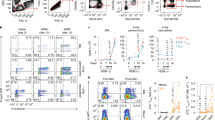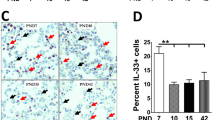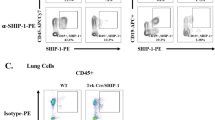Abstract
Eosinophilia is a hallmark characteristic of T helper type 2 (TH2) cell–associated diseases and is critically regulated by the central eosinophil growth factor interleukin 5 (IL-5). Here we demonstrate that IL-5 activity in eosinophils was regulated by paired immunoglobulin-like receptors PIR-A and PIR-B. Upon self-recognition of β2-microglobulin (β2M) molecules, PIR-B served as a permissive checkpoint for IL-5–induced development of eosinophils by suppressing the proapoptotic activities of PIR-A, which were mediated by the Grb2-Erk-Bim pathway. PIR-B–deficient bone marrow eosinophils underwent compartmentalized apoptosis, resulting in decreased blood eosinophilia in naive mice and in mice challenged with IL-5. Subsequently, Pirb−/− mice displayed impaired aeroallergen-induced lung eosinophilia and induction of lung TH2 cell responses. Collectively, these data uncover an intrinsic, self-limiting pathway regulating IL-5–induced expansion of eosinophils, which has broad implications for eosinophil-associated diseases.
This is a preview of subscription content, access via your institution
Access options
Subscribe to this journal
Receive 12 print issues and online access
$209.00 per year
only $17.42 per issue
Buy this article
- Purchase on Springer Link
- Instant access to full article PDF
Prices may be subject to local taxes which are calculated during checkout







Similar content being viewed by others
References
Nishinakamura, R. et al. Mice deficient for the IL-3/GM-CSF/IL-5 beta c receptor exhibit lung pathology and impaired immune response, while beta IL3 receptor-deficient mice are normal. Immunity 2, 211–222 (1995).
Sanderson, C.J. Interleukin-5, eosinophils, and disease. Blood 79, 3101–3109 (1992).
Collins, P.D., Marleau, S., Griffiths Johnson, D.A., Jose, P.J. & Williams, T.J. Cooperation between interleukin-5 and the chemokine eotaxin to induce eosinophil accumulation in vivo. J. Exp. Med. 182, 1169–1174 (1995).
Rothenberg, M.E. et al. IL-5-dependent conversion of normodense human eosinophils to the hypodense phenotype uses 3T3 fibroblasts for enhanced viability, accelerated hypodensity, and sustained antibody-dependent cytotoxicity. J. Immunol. 143, 2311–2316 (1989).
Rothenberg, M.E. & Hogan, S.P. The eosinophil. Annu. Rev. Immunol. 24, 147–174 (2006).
Wu, D. et al. Eosinophils sustain adipose alternatively activated macrophages associated with glucose homeostasis. Science 332, 243–247 (2011).
Rosenberg, H.F., Dyer, K.D. & Foster, P.S. Eosinophils: changing perspectives in health and disease. Nat. Rev. Immunol. 13, 9–22 (2013).
Chu, V.T. et al. Eosinophils are required for the maintenance of plasma cells in the bone marrow. Nat. Immunol. 12, 151–159 (2011).
Starr, T.K., Jameson, S.C. & Hogquist, K.A. Positive and negative selection of T cells. Annu. Rev. Immunol. 21, 139–176 (2003).
Ljunggren, H.G. & Karre, K. In search of the 'missing self': MHC molecules and NK cell recognition. Immunol. Today 11, 237–244 (1990).
Takai, T. Paired immunoglobulin-like receptors and their MHC class I recognition. Immunology 115, 433–440 (2005).
Kubagawa, H. et al. Biochemical nature and cellular distribution of the paired immunoglobulin-like receptors, PIR-A and PIR-B. J. Exp. Med. 189, 309–318 (1999).
Nakamura, A., Kobayashi, E. & Takai, T. Exacerbated graft-versus-host disease in Pirb−/− mice. Nat. Immunol. 5, 623–629 (2004).
Maeda, A., Kurosaki, M. & Kurosaki, T. Paired immunoglobulin-like receptor (PIR)-A is involved in activating mast cells through its association with Fc receptor gamma chain. J. Exp. Med. 188, 991–995 (1998).
Blery, M. et al. The paired Ig-like receptor PIR-B is an inhibitory receptor that recruits the protein-tyrosine phosphatase SHP-1. Proc. Natl. Acad. Sci. USA 95, 2446–2451 (1998).
Ujike, A. et al. Impaired dendritic cell maturation and increased T(H)2 responses in PIR-B(−/−) mice. Nat. Immunol. 3, 542–548 (2002).
Wheadon, H., Paling, N.R. & Welham, M.J. Molecular interactions of SHP1 and SHP2 in IL-3-signalling. Cell. Signal. 14, 219–229 (2002).
Mitsuhashi, Y. et al. Regulation of plasmacytoid dendritic cell responses by PIR-B. Blood 120, 3256–3259 (2012).
Munitz, A., McBride, M.L., Bernstein, J.S. & Rothenberg, M.E. A dual activation and inhibition role for the paired immunoglobulin-like receptor B in eosinophils. Blood 111, 5694–5703 (2008).
Dyer, K.D. et al. Functionally competent eosinophils differentiated ex vivo in high purity from normal mouse bone marrow. J. Immunol. 181, 4004–4009 (2008).
Iwasaki, H. et al. Identification of eosinophil lineage-committed progenitors in the murine bone marrow. J. Exp. Med. 201, 1891–1897 (2005).
Moshkovits, I. et al. CMRF35-like molecule 1 (CLM-1) regulates eosinophil homeostasis by suppressing cellular chemotaxis. Mucosal Immunol. 10.1038.mi.2013.47 (3 July 2013).
Uehara, T. et al. Inhibition of IgE-mediated mast cell activation by the paired Ig-like receptor PIR-B. J. Clin. Invest. 108, 1041–1050 (2001).
Karo-Atar, D., Moshkovits, I., Eickelberg, O., Konigshoff, M. & Munitz, A. Paired immunoglobulin-like receptor-B inhibits pulmonary fibrosis by suppressing profibrogenic properties of alveolar macrophages. Am. J. Respir. Cell Mol. Biol. 48, 456–464 (2013).
Voehringer, D., van Rooijen, N. & Locksley, R.M. Eosinophils develop in distinct stages and are recruited to peripheral sites by alternatively activated macrophages. J. Leukoc. Biol. 81, 1434–1444 (2007).
Bouillet, P. & O'Reilly, L.A. CD95, BIM and T cell homeostasis. Nat. Rev. Immunol. 9, 514–519 (2009).
Kopf, M. et al. IL-5-deficient mice have a developmental defect in CD5+ B-1 cells and lack eosinophilia but have normal antibody and cytotoxic T cell responses. Immunity 4, 15–24 (1996).
Rennick, D.M. et al. In vivo administration of antibody to interleukin-5 inhibits increased generation of eosinophils and their progenitors in bone marrow of parasitized mice. Blood 76, 312–316 (1990).
Rosenberg, H.F., Phipps, S. & Foster, P.S. Eosinophil trafficking in allergy and asthma. J. Allergy Clin. Immunol. 119, 1303–1310 (2007).
Tomaki, M. et al. Eosinophilopoiesis in a murine model of allergic airway eosinophilia: involvement of bone marrow IL-5 and IL-5 receptor alpha. J. Immunol. 165, 4040–4050 (2000).
Matsushita, H. et al. Differential but competitive binding of Nogo protein and class I major histocompatibility complex (MHCI) to the PIR-B ectodomain provides an inhibition of cells. J. Biol. Chem. 286, 25739–25747 (2011).
Kessels, H.W., Ward, A.C. & Schumacher, T.N. Specificity and affinity motifs for Grb2 SH2-ligand interactions. Proc. Natl. Acad. Sci. USA 99, 8524–8529 (2002).
Varol, C., Landsman, L. & Jung, S. Probing in vivo origins of mononuclear phagocytes by conditional ablation and reconstitution. Methods Mol. Biol. 531, 71–87 (2009).
van Rijt, L.S. et al. In vivo depletion of lung CD11c- dendritic cells during allergen challenge abrogates the characteristic features of asthma. J. Exp. Med. 201, 981–991 (2005).
Lanier, L.L. NK cell recognition. Annu. Rev. Immunol. 23, 225–274 (2005).
Ho, L.H., Uehara, T., Chen, C.C., Kubagawa, H. & Cooper, M.D. Constitutive tyrosine phosphorylation of the inhibitory paired Ig-like receptor PIR-B. Proc. Natl. Acad. Sci. USA 96, 15086–15090 (1999).
van den Berg, T.K. & van der Schoot, C.E. Innate immune 'self' recognition: a role for CD47-SIRPalpha interactions in hematopoietic stem cell transplantation. Trends Immunol. 29, 203–206 (2008).
Ahrens, R. et al. Intestinal macrophage/epithelial cell-derived CCL11/eotaxin-1 mediates eosinophil recruitment and function in pediatric ulcerative colitis. J. Immunol. 181, 7390–7399 (2008).
Yang, D. et al. Eosinophil-derived neurotoxin acts as an alarmin to activate the TLR2-MyD88 signal pathway in dendritic cells and enhances Th2 immune responses. J. Exp. Med. 205, 79–90 (2008).
Lee, J.J., Jacobsen, E.A., McGarry, M.P., Schleimer, R.P. & Lee, N.A. Eosinophils in health and disease: the LIAR hypothesis. Clin. Exp. Allergy 40, 563–575 (2010).
Bochner, B.S. Verdict in the case of therapies versus eosinophils: the jury is still out. J. Allergy Clin. Immunol. 113, 3–9, quiz 10 (2004).
Kano, G., Almanan, M., Bochner, B.S. & Zimmermann, N. Mechanism of Siglec-8-mediated cell death in IL-5-activated eosinophils: Role for reactive oxygen species-enhanced MEK/ERK activation. J. Allergy Clin. Immunol. 132, 437–445 (2013).
Munitz, A. et al. The inhibitory receptor IRp60 (CD300a) suppresses the effects of IL-5, GM-CSF, and eotaxin on human peripheral blood eosinophils. Blood 107, 1996–2003 (2006).
Chu, J., Liu, Y., Koretzky, G.A. & Durden, D.L. SLP-76-Cbl-Grb2-Shc interactions in FcgammaRI signaling. Blood 92, 1697–1706 (1998).
Kanamaru, Y. et al. IgA Fc receptor I signals apoptosis through the FcRγ ITAM and affects tumor growth. Blood 109, 203–211 (2007).
Zuo, L. et al. IL-13 induces esophageal remodeling and gene expression by an eosinophil-independent, IL-13R alpha 2-inhibited pathway. J. Immunol. 185, 660–669 (2010).
Koller, B.H., Marrack, P., Kappler, J.W. & Smithies, O. Normal development of mice deficient in beta 2M, MHC class I proteins, and CD8+ T cells. Science 248, 1227–1230 (1990).
Sapoznikov, A. & Jung, S. Probing in vivo dendritic cell functions by conditional cell ablation. Immunol. Cell Biol. 86, 409–415 (2008).
Acknowledgements
We thank H. Kubagawa (University of Alabama) for providing Pirb−/− mice, and S.P. Hogan, O. Mandelboim, I. Bachelet, N. Osherov and A. Ben-Baruch for critically reviewing this manuscript and helpful discussions. This work was performed in partial fulfillment of the requirements for the PhD degree of N.B.B.-M., and D.S. at Tel Aviv University. Supported by the FP7 Marie-Curie Reintegration grant (256311), the Israel Science Foundation (955/11 and 1708/11) the Israel Cancer Research Foundation Research Career Development Award and the Fritz Thyssen Foundation (to A.M.); the US-Israel Bi-national Science Foundation (2009222 to A.M. and M.E.R.); US National Institutes of Health NIAID (R01AI083450 and R37AI045898), Campaign Urging Research for Eisonophilic Disease (CURED) Foundation and Buckeye Foundation (to M.E.R.).
Author information
Authors and Affiliations
Contributions
N.B.B.-M., D.S., I.M., M.I., D.K.-A., C.B., P.C.F., D.R. and A.M. did in vitro and in vivo experiments and analyzed data. M.E.R and S.J. provided critical reagents and analyzed data. A.M. supervised the study, and wrote and edited the manuscript.
Corresponding author
Ethics declarations
Competing interests
The authors declare no competing financial interests.
Integrated supplementary information
Supplementary Figure 1 Expression of surface activation markers and adhesion molecules in Pirb–/– LDBM cells.
Expression of surface activation markers and adhesion molecules in Pirb-/- LDBM cells. LDBM cells were obtained from wild-type (WT) and Pirb–/– mice and differentiated in-vitro into eosinophils. At day 14 of the culture, cells were stained with the indicated antibodies and isotype matched control. Assessment of surface expression was conducted by flow cytometric analysis of at least 10,000 events. Delta mean fluorescent intensity (ΔMFI) was calculated by subtracting the background isotype matched control staining. Data are representative histogram plots from 3 independent experiments.
Supplementary Figure 2 Assessment of cell proliferation in Pirb–/– LDBM cell cultures.
Assessment of cell proliferation in Pirb–/– low-density bone marrow cell cultures. (a) Low-density bone marrow (LDBM) cells were obtained from wild-type (WT) and Pirb–/– mice and differentiated in vitro-into eosinophils. At the indicated time points, cellular proliferation was assessed in eosinophil progenitors EoPs, (defined as Sca1−CD34+Lin−C-KitintIL-5Rα+ cells) (b) or the general cell population using EdU. Data are representative of at least three independent experiments.
Supplementary Figure 3 Assessment of pro- and anti-apoptotic molecule expression in Pirb–/– LDBM cell culture.
Assessment of pro- and anti-apoptotic molecule expression in Pirb–/– low-density bone marrow cell culture. The expression of (a) BclXL, (b) Bax and (c) Bid was assessed in cDNA obtained from low-density bone marrow (LDBM) cells from wild-type (WT) and Pirb–/– mice by qPCR analysis. Gene expression was normalized to the house keeping gene hypoxanthine-guanine phosphoribosyltransferase (Hprt). Data are representative of LDBM cultures from n=3 mice.
Supplementary Figure 4 Siglec-F+CCR3int and Siglec-F+CCR3hi BM cells display eosinophil morphology and granule proteins.
Siglec-F+CCR3int and Siglec-F+CCR3hi bone marrow cells display eosinophil morphology and granule proteins. (a) Bone marrow cells from naïve wild-type mice were obtained and stained with anti-Siglec-F and anti-CCR3. Thereafter, Siglec-F+CCR3int and Siglec-F+CCR3hi cells were sorted, cytospins prepared and stained with modified Wright Giemsa stain. (b) The expression of eosinophil major basic protein (Mbp) was determined using qPCR. Gene expression was normalized to the house keeping gene hypoxanthine-guanine phosphoribosyltransferase (Hprt). Data are representative of LDBM cultures from n=3.
Supplementary Figure 5 Correlation analysis between PIR-B and Bim expression.
Correlation analysis between PIR-B and Bim expression. The expression of PIR-B was assessed throughout the low-density bone marrow (LDBM)-derived eosinophil culture using flow cytometric analysis at the indicated time points. Pearson correlation between PIR-B and Bim expression is shown (r = 0.47, P = 0.31).
Supplementary Figure 6 Miniphosphorpoteomics and assessment of phospho JNK and p38 in BM eosinophils.
Miniphosphorpoteomics and assessment of phospho JNK and p38 in BM eosinophils. (a) A custom-made membrane coated with various antibodies recognizing several kinases and/or adaptor molecules was used to determine the interactions between PIR-A and (b) selected phosphorylated downstream signaling intermediates. (c-d) Wild-type (WT) and Pirb–/– BM cells were stained with anti-Siglec-F, Annexin-V and anti-phospho(p)-JNK or anti-phospho(p)-p38. Thereafter, the mean fluorescence intensity of (c) phospho-Jnk 1/2 (P-Jnk 1/2) and (d) phospho-p38 (P-p38) was assessed by flow cytometry.
Supplementary Figure 7 PIR-B is required for development allergic airway inflammation.
PIR-B is required for development allergic airway inflammation. (a) Wild-type (WT) and Pirb–/– mice were sensitized with Alum+OVA on days 0 and 14. On day 24, serum was obtained; serially diluted and total IgE was assessed. (b-e) WT and Pirb–/– mice were challenged with allergen extracts of Aspergillus fumigatus (Asp) (f-g) or house dust mite (HDM). Thereafter, (b) the frequencies of CD3+CD4+ T cells and expression of (c) IL-4, (d) IL-13 and (e) CCL17 were assessed. Bronchoalveolar lavage fluid was obtained from HDM-challenged mice and (g) eosinophil percentages and (h) total numbers assessed. (i-l) Mixed bone marrow (BM) chimeric mice that harbor a specific deletion of PIR-B in their CD11c+ cell component were generated. Following adoptive transfer, engraftment of mixed BM cells from WT, Pirb–/– and CD11c-diphteria toxin receptor (CD11c-DTR) mice were assessed using anti-CD45.1 and anti-CD45.2 staining. Ablation of lung CD11c+ cells following diphtheria toxin treatment was examined. Single cell suspensions from the lungs of chimeric BM mice were obtained and (i) PIR-A/B expression as well as (j) frequencies of CD45.2+ cells assessed. Chimeric BM mice were intranasally challenged with saline or Aspergillus fumigatus (Asp) and (k) CCL17 was measured using ELISA and (l) lung IL-4 expression was assessed using qPCR analysis. Data are representative of at least two independent experiments using seven mice per group; NS-non significant, *P < 0.05, **P < 0.01, ***P < 0.001.
Supplementary Figure 8 Schematic presentation of the proposed function of PIRs in eosinophil expansion.
Schematic presentation of the proposed function of PIRs in eosinophil expansion. Exposure of eosinophils to IL-5 in the bone marrow induces eosinophil growth and expansion by delivering survival signals. In contrast to IL-5, self-recognition via PIR-A induces pro-apoptotic signaling in eosinophils and counter regulates IL-5-driven responses. PIR-B, which is expressed in eosinophils in higher levels than PIR-A, suppresses the pro-apoptotic signaling driven by PIR-A, via a pathway that likely involves activation of Bim and ERK. Thus, PIR-B serves as a permissive checkpoint for IL-5 induced eosinophil expansion.
Supplementary information
Supplementary Text and Figures
Supplementary Figures 1–8 (PDF 4864 kb)
Rights and permissions
About this article
Cite this article
Ben Baruch-Morgenstern, N., Shik, D., Moshkovits, I. et al. Paired immunoglobulin-like receptor A is an intrinsic, self-limiting suppressor of IL-5–induced eosinophil development. Nat Immunol 15, 36–44 (2014). https://doi.org/10.1038/ni.2757
Received:
Accepted:
Published:
Issue Date:
DOI: https://doi.org/10.1038/ni.2757
This article is cited by
-
Immunoglobulin-like receptors and the generation of innate immune memory
Immunogenetics (2022)
-
Necroinflammation emerges as a key regulator of hematopoiesis in health and disease
Cell Death & Differentiation (2019)
-
TCF-1 and HEB cooperate to establish the epigenetic and transcription profiles of CD4+CD8+ thymocytes
Nature Immunology (2018)
-
mTOR complexes differentially orchestrates eosinophil development in allergy
Scientific Reports (2018)
-
A key requirement for CD300f in innate immune responses of eosinophils in colitis
Mucosal Immunology (2017)



